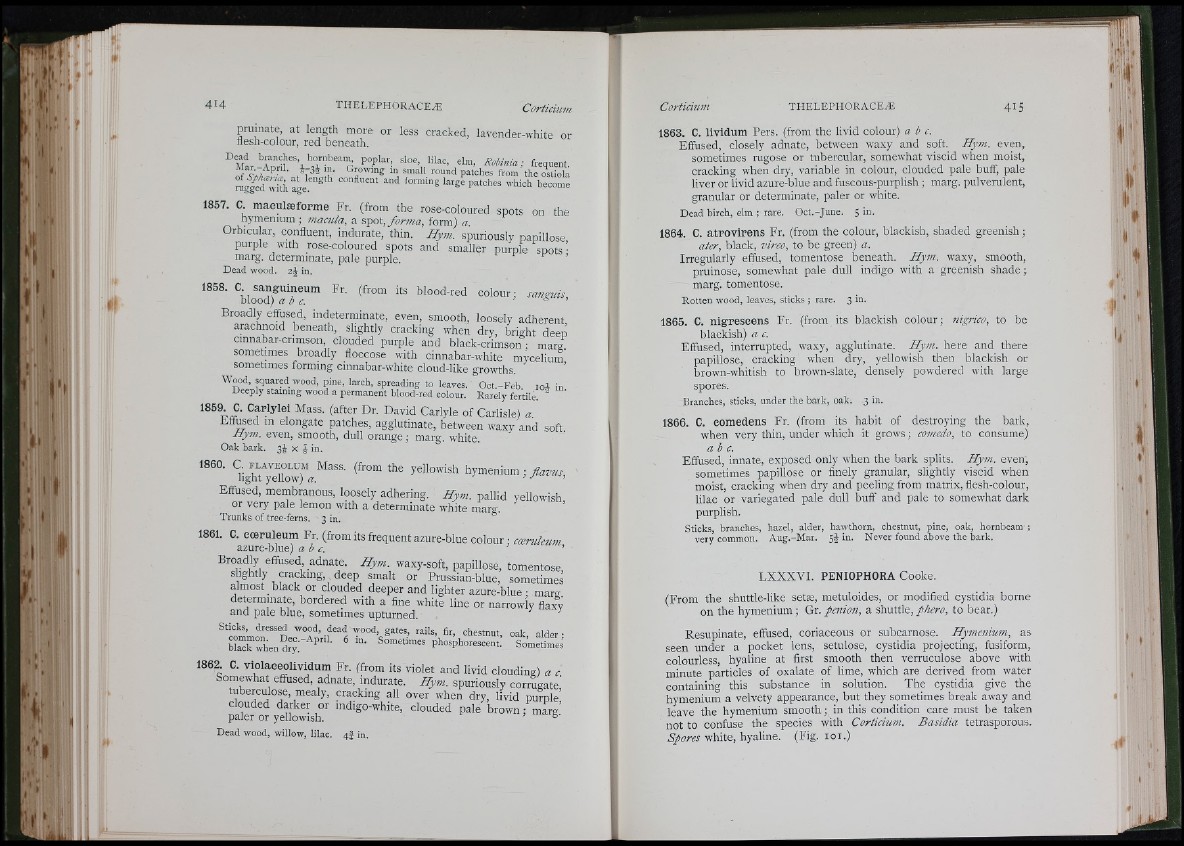
pruinate, at length more or less cracked, lavender-white or
flesh-colour, red beneath.
Dead branches, hornbeam, poplar, sloe, lilac, elm, Robinia; frequent
f v / '!’■ tound patches from the ostiola
™g|ld Utah age.®"" ' “ 5 l“ “ ing large patches which become
1857. C maeulseforme Fr. (from the rose-coloured spots on the
hymenium; macula, a spot,/«/-»/«, form) a
Orbicular, confluent, indurate, thin. Hym. spuriously papillose,
purple with rose-coloured spots and smaller purple spots-
marg. determinate, pale purple. ’
Dead wood. 2® in.
1858. Fr- (from its blood-red colour; sanguis.
Broadly efiused, indeterminate, even, smooth, loosely adherent
arachnoid beneath, slightly cracking when dry, bright deep
cinnabar-crimson, clouded purple and black-crimson mara
sometimes broadly floccose with cinnabar-white m/elium'
sometimes forming cinnabar-white cloud-like growths.
Wood, squared wood, pine, larch, spreading to leaves. O c t.-F e b lo® in
Deeply staining wood a permanent blood-red colour. Rarely fertile.
1859 C. Carlylm Mass. (after Dr. David Carlyle of Carlisle) «
Effused in elongate patches, agglutinate, between waxy and soft.
Hym. even, smooth, dull orange; marg. white.
Oak bark. 3 | X ^ in.
Effused, membranous, loosely adhering. Hym. pallid yellowish
or very pale lemon with a determinate white marg. ’
Trunks of tree-ferns. 3 in.
1861. C. eoeruleum Fr. (from its frequent azure-blue colour; ccerulenm
azure-blue) abc. ’
Broadly effused adnate. Hym. waxy-soft, papillose, tomentose,
s ightly cracking, deep smalt or Prussian-blue, sometime^
almost black or clouded deeper and lighter azure-blue • marg
determinate, bordered with a fine white line or narrowly flaxy
and pale blue, sometimes upturned.
'ft'®"" re • / " ‘I gates, rails, fir, chestnut, oak, alder •
M a T w h e n ^ “ ; -^ ^ " '- ' Pft-Phorescent: SometimL’
1862 C. violaeeolividum Fr. (from its violet and livid clouding) « «
Somewhat effused, adnate, indurate. Hym. spuriously corrugate'
tuberculose, mealy, cracking all over when dry, livid purple’
clouded darker or mdigo-white, clouded pale brown; marg’
paler or yellowish. / “ SDead
wood, willow, lilac. 4I in.
t
4 1 S
1863. C. lividum Pers. (from the livid colour) abc.
Effused, closely adnate, between waxy and soft. Hym. even,
sometimes rugose or tubercular, somewhat viscid w'hen moist,
cracking when dry, variable in colour, clouded pale buff, pale
liver or livid azure-blue and fuscous-purplish; marg. pulverulent,
granular or determinate, paler or white.
Dead birch, elm ; rare. Oct.-June. 5 in.
1864. C. atrovirens Fr. (from the colour, blackish, shaded greenish;
ater, black, vireo, to be green) a.
Irregularly effused, tomentose beneath. Hym. waxy, smooth,
pruinose, somewhat pale dull indigo with a greenish shade;
marg. tomentose.
Rotten wood, leaves, sticks ; rare. 3 in.
1865. C. nigrescens Fr. (from its blackish colour; nigrico, to be
blackish) a c.
Effused, interrupted, waxy, agglutinate. Hym. here and there
papillose, cracking when dry, yellowish then blackish or
larown-whitish to brown-slate, densely powdered with large
spores.
Branches, sticks, under the bark, oak. 3 in.
1866. C. eomedens Fr. (from its habit of destroying the bark,
when very thin, under which it grows; comedo, to consume)
abc.
Effused, innate, exposed only when the bark splits. Hym. even,
sometimes papillose or finely granular, slightly viscid when
moist, cracking when dry and peeling from matrix, flesh-colour,
lilac or variegated pale dull buff and pale to somewhat dark
purplish.
Sticks, branches, hazel, alder, hawthorn, chestnut, pine, oak, hornbeam ;
very common. Aug.-Mar. 5® in. Never found above the bark.
- H
I*
LXXXVI. PENIOPHORA Cooke.
(From the shuttle-like setæ, metuloides, or modified cystidia borne
on the hymenium ; Gr. penion, a shuttle, phero, to bear.)
Resupinate, effused, coriaceous or subcarnose. Hymenium, as
seen under a pocket lens, setulose, cystidia projecting, fusiform,
colourless, hyaline at first smooth then verruculose above with
minute particles of oxalate of lime, which are derived from water
containing this substance in solution. The cystidia give the
hymenium a velvety appearance, but they sometimes break away and
leave the hymenium smooth ; in this condition care must be taken
not to confuse the species with Corticium. Basidia tetrasporous.
Spores white, hyaline. (Fig. lo i.)